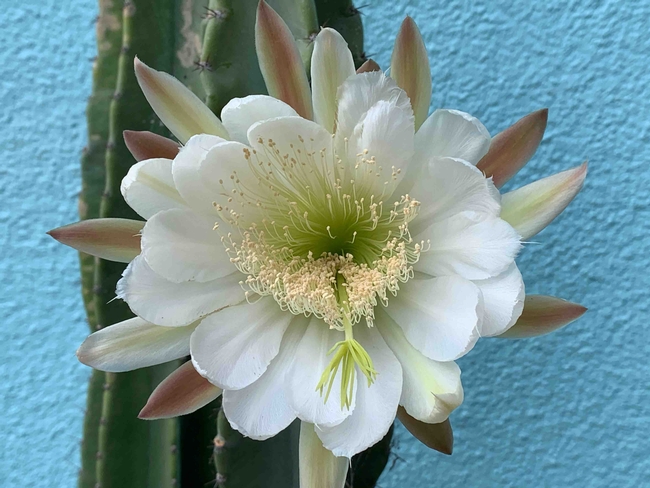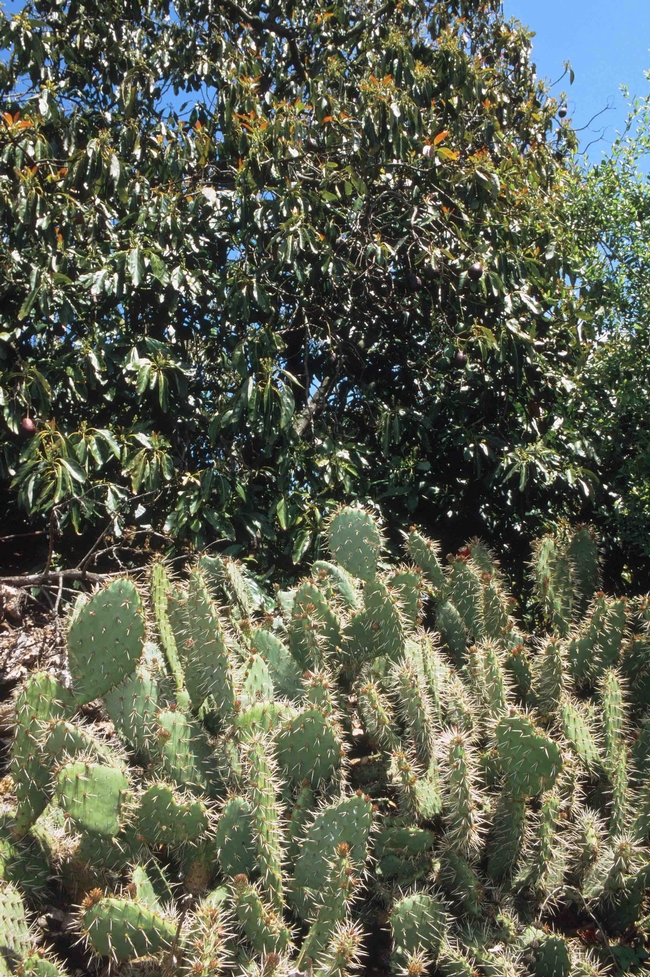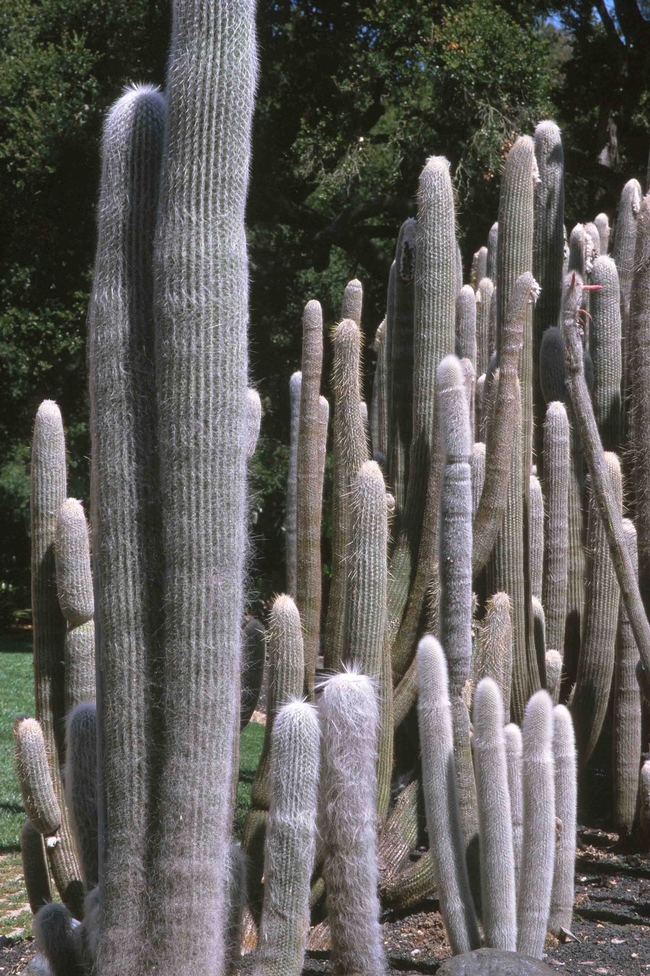With our long, hot summers and drought seemingly becoming the norm, many home gardeners are on the lookout for water-efficient plants. Although often overlooked, the cacti found in North and South American deserts fit this purpose nicely, and as an added bonus most species have colorful, often spectacular, blooms. While there are also species of cacti found in cloud forests and even rainforests, these would not be appropriate for outdoor landscaping in the Northstate.

In the absence of leaves, the green stems of cacti have taken over the job of photosynthesis. In most plants, stomata (pores) on the leaves open during the day to allow for the uptake of carbon dioxide and release of oxygen during photosynthesis. This creates a problem for plants living in arid climates because whenever their stomata are open, water evaporates from them. Cacti and several other plant families have resolved this issue by utilizing a metabolic pathway known as crasssulacean acid metabolism (CAM). On the CAM pathway, stomates are closed during the day and open at night, limiting the loss of water. While their stomates are open at night, CAM plants take in carbon dioxide, store it in the form of malic acid, and then release the carbon dioxide from the malic acid the next day so that it is available for use in photosynthesis. This process requires the expense of a lot of energy, but since plants depend on solar energy, it is not an issue for sun-drenched desert plants like cacti.

Many cacti have shallow root systems that extend widely to quickly absorb as much moisture as possible from rare rainfalls. A cactus that is just a few inches tall may have roots reaching out several feet.
Cacti can be grown in any sunny, well-drained area. Smaller varieties can be kept as potted houseplants; hardy species can be grown as landscape plants, either in pots or in the ground. The best time to plant a cactus is in the late spring or summer, when its roots are actively growing. Always plant cacti bareroot. Let the soil in the pot dry out and then gently loosen the soil in the root ball and shake it off.
When planting a cactus, prepare a hole that is as deep as the plant's root ball and one and one-half times as wide. Place the cactus so that its stem is at the same depth it was before transplanting. Use heavy gloves and/or a thick layer of newspaper wrapped around the plant when handling a cactus. If your native soil is coarse textured and drains well, you can use it to fill in the hole and then pack it firmly around the root ball. If your soil is heavy and doesn't drain well, it would be wise to dig a deeper hole and backfill it with cactus mix. There are several cactus mixes available commercially, but if you want to make your own, a good recipe is three parts sand, three parts regular soil and two parts pumice or perlite. Planting cacti in raised or mounded beds is another work-around for slow draining, heavy soils.
If your cactus came from a lath house or outdoor greenhouse, protect it with a shade cloth for a couple of weeks. This will help it acclimate to the stronger outdoor sun and the cactus will be less likely to become sunburned while its outer skin toughens up. Once the cactus is in the ground, it should be watered until the soil is about as damp as a wrung-out sponge. While cacti require minimal care, their number one cause of death is over watering, so after the initial watering wait and don't water again until the top two or three inches of soil are dry. If your cactus looks a little shriveled, you may need to water it sooner. Cacti in pots usually need to be watered more often than those that are planted directly in the ground. Most cacti are dormant in the fall and winter, so they need little, if any, water then.
Cacti can be frost sensitive, but there are several genera that more cold-hardy. Cold-hardy genera include (but are not limited to): Opuntia, Ferocactus, Echinocereus, Escobaria, Corypantha and some species in the genera Cereus and Mammalaria. It is important to note that in many instances, “it's not the cold, but the wet” that can kill these cacti.
Opuntia cacti are also known as beaver-tail, or prickly pear cactus. Their stems consist of flattened, segmented pads. Most species of Opuntia have yellow flowers, but species with vivid purple, pink, red, or orange flowers are common as well. Opuntias can range in size from less than a foot to 15 feet tall. Their fruit is edible, but care must be taken to remove the spines before eating it. Young stems, called pads or nopales, are also edible and are an important part of Mexican cuisine.
Members of the genus Ferocactus are large, deeply ribbed, barrel-shaped cacti. Their “fishhook” spines often form an almost impenetrable armored web around the plant body. Their flowers can be pink, yellow, red, or purple, depending on the species. Ferocactus plants can range in size from less than a foot to over 12 feet tall, but most species are between one and four feet tall. Although these barrel cacti do contain water, it is not considered potable and is likely to cause diarrhea if it is ingested.
Echinocereus is commonly known as the hedgehog cactus. It is a relatively small, columnar cactus, with species seldom growing more than a foot tall. Although these plants are small, various species often produce masses of purple, red, pink or yellow flowers. Echinocereus spines can be tinged with pink, producing interesting color patterns on their stems.
Escobaria, commonly called pincushion cactus or foxtail cactus, is different from most other cacti in that it lacks ribs. Instead, Escobaria cacti have lobed protrusions called tubercles. Species in this genus are generally no more than six inches tall and can be columnar or globe-shaped. They can be solitary or grow in clusters and their flowers vary from yellow to pink, red and purple. Several Escobarias are extremely cold-hardy; this widespread genus is found from Mexico to Canada.
Coryphantha cacti, commonly known as beehive cacti, are very similar to Escobaria. To the layperson, they may look the same, but botanists have placed them in different genera because of significant differences in their seed coats. The Coryphantha genus is not as widespread as Escobaria and most species are uncommon.

Members of the genus Cereus are large, columnar, night-blooming cacti, but cereus is also used as the common name for several other night-blooming genera of cacti. Many members of the genus Cereus are frost-sensitive, but one Peruvian species, Cereus peruvianus, is hardy to 18° F! C. peruvianus, the Peruvian apple cactus, commonly grows to eight feet tall, but can reach heights upwards of 20 feet, making it an impressive focal point for a cactus garden. The flowers of the Peruvian apple cactus are large and white and last just one night; the petals wither in the morning sun. Its pollinator is a moth and if pollination is successful a large, red, spine-free fruit will develop. As its name implies, this fruit is edible. The flesh of the Peruvian apple cactus is crunchy and has been described as refreshingly juicy with a subtly tart sugarcane taste.
Plant Sale! The Master Gardeners will hold their Fall 2021 Plant Sale on October 30, from 9am to 1pm at the Demonstration Garden at Patrick Ranch (10381 Midway, Durham). Along with the Plant Sale, there will be two free workshops: “Gardening with Natives” at 10am, and “Berry and Grape Gardening” at 11am. No registration is required for these workshops; Covid safety protocols will be followed.
UC Master Gardeners of Butte County are part of the University of California Cooperative Extension (UCCE) system. To learn more about us and our upcoming events, and for help with gardening in our area, visit our website. If you have a gardening question or problem, email the Hotline at mgbutte@ucanr.edu (preferred) or call (530) 538-7201.


